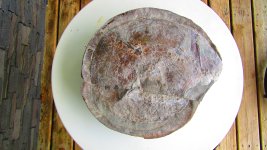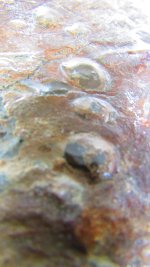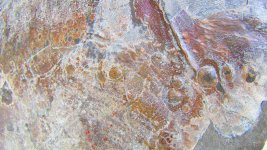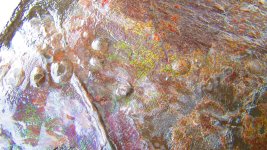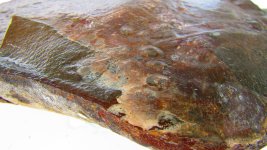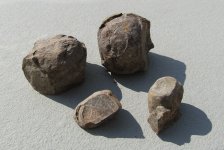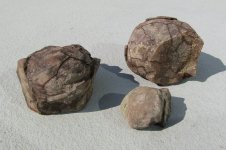You are using an out of date browser. It may not display this or other websites correctly.
You should upgrade or use an alternative browser.
You should upgrade or use an alternative browser.
Why?
- Thread starter pearlescence
- Start date
Lagoon Island Pearls
Well-known member
- Joined
- Dec 8, 2009
- Messages
- 2,143
As we were at one point convinced that we observed Foliated Aragonite under electron microscopy in purported Nautilus pearls, there was reason to believe that a genetic basis existed for the production of non-nacreous pearls by a nacreous Cephalopoda shell.
That actually remains an open, if abandoned, line of research. While DNA extraction has since proven viable for nacreous pearls, it is not yet appllicable to non-nacreous pearls, which would offer ultimate resolution of the matter.
I have no doubt DNA is largely implicated in shell development, however I have doubts it's a singular factor in pearl formation. Pearl sacs and surface structure of pearls are greatly dependant upon the proximity of the nucleus. A normal shell has four stages of growth during each consecutive growth cycle. Periostracial > Prismatic > Nacreous > Calcitic. The "nacreous" period may be substituted in different molluscs. For example Pododesmus macrochisma, which is structured with foliated calcite instead of aragonite. Here's the kicker, even though podo oysters layup foliated calcite next to the pallial mantle, the vestibular mantle produces nacreous surfaces which support the adhesion and expansion of the adductor muscles. Proximity matters. In that species pallial mantles produce foliated calcite pearls, while vestibular mantles produce highly nacreous pearls.
This may also be observed in granular pearls, where much of the regenerative DNA is lost or never present, but the tissue is still viable, hence the pearl is not replicated identical to the donor, instead merely from scar tissue. Sure, it's DNA nonetheless, but not necessarily practical to identity.
It's why controls are important in science so single factors are not categorized as absolute, instead as a rate of occurance under certain conditions.
That covers homogeneic pearls. Namely intermyostracial viability in cultured oceania pearls and endopallial viability in FWP. Then there are xenogenic pearls, where the mantle of the parasite (for example) inadvertently expresses with viability. In which case, DNA in the pearl identifies the parasite (or pseudo-graft), not the host.
A database of genetic material can be helpful identifying cultural origins because of known processes, however in natural origin there are multiple etiological factors (and/or combinations thereof) implicating the formation of pearls. Unless these are observed in situ and peri-mortem, I am skeptical reverse specification is practical from DNA analysis alone.
SteveM
Well-known member
- Joined
- Jan 29, 2007
- Messages
- 2,113
One of the most fascinating aspects of Nautilus mineralization was the evidence of multiple forms of aragonite microstructure, including both types of nacre (columnar and terraced), a property shared with Ammonites as evidenced by the distinct colors of ammolite originating in the fossilized nacre microstructures.
Lagoon Island Pearls
Well-known member
- Joined
- Dec 8, 2009
- Messages
- 2,143
Indeed.One of the most fascinating aspects of Nautilus mineralization was the evidence of multiple forms of aragonite microstructure, including both types of nacre (columnar and terraced), a property shared with Ammonites as evidenced by the distinct colors of ammolite originating in the fossilized nacre microstructures.
While we speculated back in the day, it was refreshing to subsequently discover shell anomalies supportive of those suggestions.
The Royal Tyrell Museum was dumbfounded by this discovery. Pearls never occurred to them. They've invited our group to inspect their collection for the existence of pearls. Quite a privilege! Covid put a damper on things, but now that the museum is open and continuing it's learning curriculum, it's time to revisit this project.
Although I found fossil pearls in other specimens on a shell agreement lease in Alberta, this piece came to me from a third party, hence it was glued back together which is not an uncommon thing with fossils. However, had they not done this, I would have been able to observe a profile of the subsurface structure of the anomalies. The piece was not considered gem quality thus acquired for it's scientific value only. I am reticent to re-break or otherwise destroy this shell unless I find another.
Attachments
CortezPearls
PG Forum Admin
Quite a find! And the information it could reveal...but I agree with you: I would not touch it, I would be afraid to damage it.Indeed.
While we speculated back in the day, it was refreshing to subsequently discover shell anomalies supportive of those suggestions.
The Royal Tyrell Museum was dumbfounded by this discovery. Pearls never occurred to them. They've invited our group to inspect their collection for the existence of pearls. Quite a privilege! Covid put a damper on things, but now that the museum is open and continuing it's learning curriculum, it's time to revisit this project.
Although I found fossil pearls in other specimens on a shell agreement lease in Alberta, this piece came to me from a third party, hence it was glued back together which is not an uncommon thing with fossils. However, had they not done this, I would have been able to observe a profile of the subsurface structure of the anomalies. The piece was not considered gem quality thus acquired for it's scientific value only. I am reticent to re-break or otherwise destroy this shell unless I find another.
SteveM
Well-known member
- Joined
- Jan 29, 2007
- Messages
- 2,113
During my search for Cephalopod pearl precedents in the paleontological literature I came across the research of Michael House. His 1960 paper 'Abnormal Growths in Devonian Goniatids' described regular shell blister impressions in the fossil matrix, ascribed to the mollusk's defense against parasites while continuing to move within the shell during periodic septal formation. These became known as 'Housean Pits'. The fossils from Alberta appear to be preserved shell 'positives' of Housean Pits.The Royal Tyrell Museum was dumbfounded by this discovery. Pearls never occurred to them. They've invited our group to inspect their collection for the existence of pearls. Quite a privilege! Covid put a damper on things, but now that the museum is open and continuing it's learning curriculum, it's time to revisit this project.
Although I found fossil pearls in other specimens on a shell agreement lease in Alberta, this piece came to me from a third party, hence it was glued back together which is not an uncommon thing with fossils. However, had they not done this, I would have been able to observe a profile of the subsurface structure of the anomalies. The piece was not considered gem quality thus acquired for it's scientific value only. I am reticent to re-break or otherwise destroy this shell unless I find another.
HERE is a NatGeo article from 2011 reporting followup research by Kenneth de Baets.
Last edited:
CortezPearls
PG Forum Admin
A very interesting article @SteveM
And since these creatures used to swim in the seas (not on the bottom) it makes sense no grain of sand was there to create any pearl.
Parasites. An ongoing battle for all Life forms.
Political parasites are worse: they may attack millions without the need to infect biologically!
And since these creatures used to swim in the seas (not on the bottom) it makes sense no grain of sand was there to create any pearl.
Parasites. An ongoing battle for all Life forms.
Political parasites are worse: they may attack millions without the need to infect biologically!
SteveM
Well-known member
- Joined
- Jan 29, 2007
- Messages
- 2,113
But biology is the source of all earthly things beyond igneous rocks.Political parasites are worse: they may attack millions without the need to infect biologically!
P.S. Despite our deviations here, the thread title remains wholly appropriate!
Last edited:
Lagoon Island Pearls
Well-known member
- Joined
- Dec 8, 2009
- Messages
- 2,143
Predators and bumps against rocks can create points of entry too. Fragments of their own shells impaled in just the right place could perforate mantles enough to give rise to pearls too I suppose, but free pearls may be lost (or at least not visible) in fossils. One's attached to the shell are much more discernible. I did find two other loose pearls in a field specimen, which the museum retained/ascended. I'll look for those images in myAnd since these creatures used to swim in the seas (not on the bottom) it makes sense no grain of sand was there to create any pearl.
Parasites.
It's hard to see in the imagery, but this specimen replicated the anomalies in successive growth cycles.
And Steve, thanks for the link, a good read.
SteveM
Well-known member
- Joined
- Jan 29, 2007
- Messages
- 2,113
Look forward to images!Predators and bumps against rocks can create points of entry too. Fragments of their own shells impaled in just the right place could perforate mantles enough to give rise to pearls too I suppose, but free pearls may be lost (or at least not visible) in fossils. One's attached to the shell are much more discernible. I did find two other loose pearls in a field specimen, which the museum retained/ascended. I'll look for those images in my
It's hard to see in the imagery, but this specimen replicated the anomalies in successive growth cycles.
And Steve, thanks for the link, a good read.
Definitely see the replication, as described by House, regularly-spaced blisters from the successive septal growth cycles. Sort of like volcano island chains (Hawai'i). Evidence of loose fossilized pearls would be earth-shaking. But assuming what you have seen is ammolite, however improbable, then we are back to square one regarding the persistant historical accounts of non-nacreous pearls from a cephalopod shell!
Editing to reitierate that there is nothing in the modern or paleontological literature confirming loose Cephalopod pearls (the one GIA-certified example having been debunked), thus anything from Bear Paw would be remarkable, ammolite or otherwise.
Last edited:
SteveM
Well-known member
- Joined
- Jan 29, 2007
- Messages
- 2,113
The thought occurred that the discovery of a fossilized Ammonite pearl should be more anticipated than from a modern Nautilus shell, as the pearl would not yet have been ejected from the mantle and lost to sea. Advise those folks in Alberta to be on the lookout!
Last edited:
Lagoon Island Pearls
Well-known member
- Joined
- Dec 8, 2009
- Messages
- 2,143
Yes, I've advised a few blue zone collectors to keep an eye out.The thought occurred that the discovery of a fossilized Ammonite pearl should be more anticipated than from a modern Nautilus shell, as the pearl would not yet have been ejected from the mantle and lost to sea. Advise those folks in Alberta to be on the lookout!
I've ruled out the larger specimens as filled gas nodules. I've subsequently found several of these in other field specimens. However, the smaller one's are structured much differently and present with minor aragonite on the surfaces. Both were in immediate proximity of one another. They are currently locked up in the museum until we develop a protocol for an objective examination. We have two, so it's likely we may slice one if X-ray analysis suggests.
Attachments
SteveM
Well-known member
- Joined
- Jan 29, 2007
- Messages
- 2,113
Aragonite present would demand SEM/TEM analysis by a top shell microstructure authority. There would be no better choice than Professor Antonio Checa in Granada....present with minor aragonite on the surfaces...They are currently locked up in the museum until we develop a protocol for an objective examination.
SteveM
Well-known member
- Joined
- Jan 29, 2007
- Messages
- 2,113
Fossilized cyst pearls displaying concentric growth, preserved upon attachment to the shell of a species belonging to Conulariida, a family related to jellyfish, known for its hard conical/rectangular form, extinct for over 200 million years. Wiki gives the original pre-aragonite carbonate material as "francolite." This is my first awareness of a pearl fossil other than a blister. Image below, pertinent text follows.

Babcock, L.E. (1990)
Evolutionary Paleobiology of Behavior and Coevolution.
Elsevier Scientific Publishing, 725 pp.
Conulariid Pearls. pp. 68-71
Pearls are reported here for the first time in the extinct animal phylum Conulariida. Representatives of the Conulariida are characterized by an elongate, four-sided pyramidal exoskeleton composed of calcium phosphate. The exoskeleton has a weak bilateral symmetry and numerous pairs of transverse rods supporting a multilayered integument (Babcock and Feldmann, 1986). Unquestioned conulariids have been found in rocks of Early Ordovician to Late Triassic age. Pearls (Fig. 52A-D) are rare and have been found in only two species, Paraconularia crustula (White) from the Pennsylvanian of Johnson County, Kansas (USNM 435350), and P. magna (Ries) from the Pennsylvanian of Okfuskee County, Oklahoma (USNM 435351, 435352). They are found adhering either to inner layers of integument in examples having a partially exfoliated exoskeleton (Fig. 52A, B,) or to steinkerns where the exoskeleton has been removed. Examined pearls seem to be of the blister type but some may have initially been cyst pearls that were later incorporated into the inner layers of the exoskeleton. The maximum number of pearls found in one specimen is three and the largest such structure is 2 mm in diameter. Conulariid pearls are composed of numerous fine concentric laminae (Fig. 52C, D) of calcium phosphate. Investigation under high magnification revealed that the laminae are cryptocrystalline. Evidently, these phosphatic concretions formed by the sequential deposition of thin layers of collophane around foreign irritants that affected either the internal exoskeletal surface or soft tissues that bounded it. The irritants that stimulated the formation of pearls are not known. By analogy with pearls formed naturally by present-day mollusks, however, it is probable that many developed around parasites or boring endobionts. Sediment grains may also have served as nuclei. The presence of pearls in conulariids supports evidence (Babcock et al., 1987) that a mantle or mantle-like tissue bounded the internal surface of the exoskeleton and was responsible for its secretion.
Lagoon Island Pearls
Well-known member
- Joined
- Dec 8, 2009
- Messages
- 2,143
This is my first awareness of a pearl fossil other than a blister. Image below, pertinent text follows.
I collected this rare specimen from the Bow River near Brooks, Alberta in 2020. It's been ascended to the collection at the Royal Tyrell Museum.
I'm not 100% sure of the species, but speculate Exogyra ponderosa.
One is a myostracial (probably endogonadal) posterior ventral "loose" pearl. and the other is a periostracial anterior peduncular pearl.
SteveM
Well-known member
- Joined
- Jan 29, 2007
- Messages
- 2,113
Will the museum plan to section or try CT to determine interior structure?View attachment 471732View attachment 471733View attachment 471734View attachment 471735
I collected this rare specimen from the Bow River near Brooks, Alberta in 2020. It's been ascended to the collection at the Royal Tyrell Museum.
I'm not 100% sure of the species, but speculate Exogyra ponderosa.
One is a myostracial (probably endogonadal) posterior ventral "loose" pearl. and the other is a periostracial anterior peduncular pearl.
Lagoon Island Pearls
Well-known member
- Joined
- Dec 8, 2009
- Messages
- 2,143
Eventually I suppose. These and a few other specimens collected are in a specialty vault. They were collected at the Covid-19 onset thus the museum took quite a hit being closed to the public during that time. The good news being they've invited "my group" to examine their collection for the existence of pearls. You might do well to attend also. It's quite an extraordinary opportunity!Will the museum plan to section or try CT to determine interior structure?
SteveM
Well-known member
- Joined
- Jan 29, 2007
- Messages
- 2,113
Would love to.The good news being they've invited "my group" to examine their collection for the existence of pearls. You might do well to attend also. It's quite an extraordinary opportunity!
Lagoon Island Pearls
Well-known member
- Joined
- Dec 8, 2009
- Messages
- 2,143
Rather than merely hit and run, I'd prefer it be part of a seminar or course. These things take time because it's part of curriculum that needs a proposal, planning and execution. I'd welcome students and scientists in related fields. Each of our group having a presentation time with imagery and a talk.Would love to.
The museum responded astonishingly that fossil pearls had never occurred to any of them, thus extended this invitation.
Similar threads
- Replies
- 8
- Views
- 2K
- Replies
- 6
- Views
- 3K
- Replies
- 99
- Views
- 17K
- Replies
- 39
- Views
- 8K

